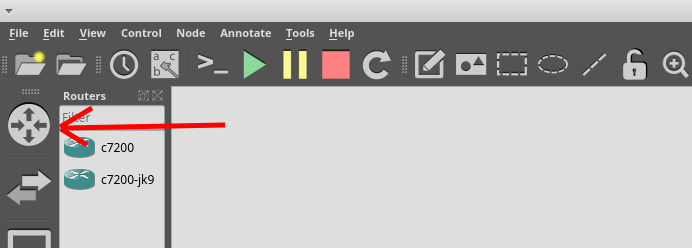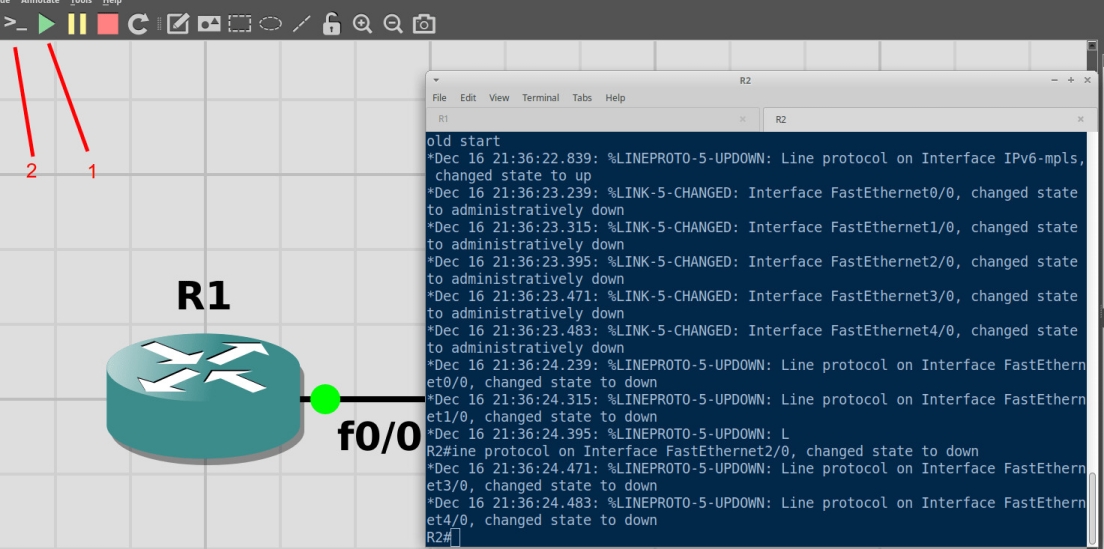Mainly based on an official tutorial (link).
A Google Drive with several Cisco IOS: https://drive.google.com/drive/folders/102jxZ9ECpe6ZFtXYdK_81iEVuuFoGOGR.
In this tutorial, the c7200 is used. You may not have the same interfaces in another case.
Topology creation
Take two c7200 routers and add them to the schematic by a “drag and drop”.

We can see our two routers:

Use the link icon in order to… …link them. In this case, we connect the FastEthernet0/0 interfaces of the routers.

Below, the green Start button (marked #1) and the Console button (marked #2) have been selected.

Now, let’s configure the routers. Reminder: GNS3 runs IOS images, it’s like playing with a real router (commands are the same).
Routers configuration
1
2
3
4
5
6
7
|
R1# sh ip int br
Interface IP-Address OK? Method Status Protocol
FastEthernet0/0 unassigned YES unset administratively down down
FastEthernet1/0 unassigned YES unset administratively down down
FastEthernet2/0 unassigned YES unset administratively down down
FastEthernet3/0 unassigned YES unset administratively down down
FastEthernet4/0 unassigned YES unset administratively down down
|
As you can see, all interfaces are administratively down. Same thing for R2:
1
2
3
4
5
6
7
|
R2# sh ip int br
Interface IP-Address OK? Method Status Protocol
FastEthernet0/0 unassigned YES unset administratively down down
FastEthernet1/0 unassigned YES unset administratively down down
FastEthernet2/0 unassigned YES unset administratively down down
FastEthernet3/0 unassigned YES unset administratively down down
FastEthernet4/0 unassigned YES unset administratively down down
|
Let’s configure fa0/0 and loopback0 interfaces:
1
2
3
4
5
6
7
8
9
10
11
12
13
14
|
R1# conf t
R1(config)# int fa0/0
R1(config-if)#ip add 10.1.1.1 255.255.255.0
R1(config-if)#int loop 0
R1(config-if)#ip add 1.1.1.1 255.255.255.255
R1(config-if)# end
R1#sh ip int br
Interface IP-Address OK? Method Status Protocol
FastEthernet0/0 10.1.1.1 YES manual administratively down down
FastEthernet1/0 unassigned YES unset administratively down down
FastEthernet2/0 unassigned YES unset administratively down down
FastEthernet3/0 unassigned YES unset administratively down down
FastEthernet4/0 unassigned YES unset administratively down down
Loopback0 1.1.1.1 YES manual up up
|
Interfaces are correctly configured. There’s only one difference: loopback virtual interfaces are automatically enabled (up state). In order to enable fa0/0:
1
2
3
4
5
6
7
8
9
10
11
12
|
R1# conf t
R1(config)#int fa0/0
R1(config-if)#no shut
R1(config-if)#end
R1#sh ip int br
Interface IP-Address OK? Method Status Protocol
FastEthernet0/0 10.1.1.1 YES manual up up
FastEthernet1/0 unassigned YES unset administratively down down
FastEthernet2/0 unassigned YES unset administratively down down
FastEthernet3/0 unassigned YES unset administratively down down
FastEthernet4/0 unassigned YES unset administratively down down
Loopback0 1.1.1.1 YES manual up up
|
Let’s configure R2:
1
2
3
4
5
6
7
8
9
10
11
12
13
14
15
|
R2#conf t
R2(config)#int fa0/0
R2(config-if)#no shut
R2(config-if)#ip add 10.1.1.2 255.255.255.0
R2(config-if)#int loop 0
R2(config-if)#ip add 2.2.2.2 255.255.255.255
R2(config-if)# end
R2#sh ip int br
Interface IP-Address OK? Method Status Protocol
FastEthernet0/0 10.1.1.2 YES manual up up
FastEthernet1/0 unassigned YES unset administratively down down
FastEthernet2/0 unassigned YES unset administratively down down
FastEthernet3/0 unassigned YES unset administratively down down
FastEthernet4/0 unassigned YES unset administratively down down
Loopback0 2.2.2.2 YES manual up up
|
We can have some information about the IOS with the following command:
1
2
3
4
5
6
|
R2#sh ver
Cisco IOS Software, 7200 Software (C7200-JK9S-M), Version 12.4(13b), RELEASE SOFTWARE (fc3)
Technical Support: http://www.cisco.com/techsupport
Copyright (c) 1986-2007 by Cisco Systems, Inc.
Compiled Wed 25-Apr-07 03:18 by prod_rel_team
[...]
|
By now, R1 and R2 can talk to each other:
1
2
3
4
5
|
R2#ping 10.1.1.1
Type escape sequence to abort.
Sending 5, 100-byte ICMP Echos to 10.1.1.1, timeout is 2 seconds:
.!!!!
Success rate is 80 percent (4/5), round-trip min/avg/max = 44/57/64 ms
|
Only 80% of packets are received, don’t worry! The first packet is lost due to the ARP address resolution (reminder: ARP is mainly responsible for translating IP to MAC addresses).
Here is a ping in the other direction:
1
2
3
4
5
|
R1#ping 10.1.1.2
Type escape sequence to abort.
Sending 5, 100-byte ICMP Echos to 10.1.1.2, timeout is 2 seconds:
!!!!!
Success rate is 100 percent (5/5), round-trip min/avg/max = 60/62/68 ms
|
100% of packets are received as the ARP exchange is already done!
OSPF routing
1
2
3
4
5
6
7
8
9
10
|
R1#conf t
R1(config)#router ospf 1
R1(config-router)#router-id 1.1.1.1
R1(config-router)#network 0.0.0.0 255.255.255.255 area 0
R1(config-router)#end
R2#conf t
R2(config)#router ospf 1
R2(config-router)#router-id 2.2.2.2
R2(config-router)#network 0.0.0.0 255.255.255.255 area 0
R2(config-router)#end
|
List of R2 neighbors:
1
2
3
|
R2#sh ip ospf neigh
Neighbor ID Pri State Dead Time Address Interface
1.1.1.1 1 FULL/DR 00:00:32 10.1.1.1 FastEthernet0/0
|
1.1.1.1 is the address of R1.
R1 routing table:
1
2
3
4
5
6
7
8
9
10
11
12
13
14
15
16
17
18
19
20
21
22
|
R1#sh ip route
Codes: C - connected, S - static, R - RIP, M - mobile, B - BGP
D - EIGRP, EX - EIGRP external, O - OSPF, IA - OSPF inter area
N1 - OSPF NSSA external type 1, N2 - OSPF NSSA external type 2
E1 - OSPF external type 1, E2 - OSPF external type 2
i - IS-IS, su - IS-IS summary, L1 - IS-IS level-1, L2 - IS-IS level-2
ia - IS-IS inter area, * - candidate default, U - per-user static route
o - ODR, P - periodic downloaded static route
Gateway of last resort is not set
1.0.0.0/32 is subnetted, 1 subnets
C 1.1.1.1 is directly connected, Loopback0
2.0.0.0/32 is subnetted, 1 subnets
O 2.2.2.2 [110/2] via 10.1.1.2, 00:08:21, FastEthernet0/0
10.0.0.0/24 is subnetted, 1 subnets
C 10.1.1.0 is directly connected, FastEthernet0/0
R1#ping 2.2.2.2
Type escape sequence to abort.
Sending 5, 100-byte ICMP Echos to 2.2.2.2, timeout is 2 seconds:
!!!!!
Success rate is 100 percent (5/5), round-trip min/avg/max = 8/24/72 ms
|
There’s the OSPF route towards 2.2.2.2. On the R2 side:
1
2
3
4
5
|
R2#ping 1.1.1.1
Type escape sequence to abort.
Sending 5, 100-byte ICMP Echos to 1.1.1.1, timeout is 2 seconds:
!!!!!
Success rate is 100 percent (5/5), round-trip min/avg/max = 12/28/40 ms
|
Router configuration backup
By default, GNS3 won’t save routers configuration. It can be done manually:
1
|
R1#copy running-config startup-config
|
Next time GNS3 is launched, routers will still be configured!



